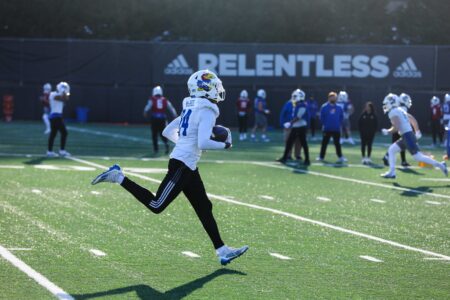Kansas loses 2 grants
It’s now out there: a very good reason Kansas University’s football team signed only 20 players last month on signing day.
KU released its data regarding Academic Progress Rate on Monday, and the football team’s four-year average score of 919 was below the NCAA’s penalty-free floor of 925.
That, coupled with the Jayhawks having two players leave school in poor academic standing last school year, meant Kansas had to forfeit two scholarships in its 2008 recruiting class.
KU already appealed the penalty, citing positive steps in the area of graduation rate, grade-point average and academic honors. That appeal, however, was denied.
“Despite the loss of two scholarships, we are very pleased with the direction the football program is taking,” associate athletic director Jim Marchiony said. “It’s obvious to us the program is on the right track academically.”
APR is calculated by giving athletes on scholarship one point per semester for remaining eligible and one point for remaining on campus. The points then are calculated for each team and divided by the highest possible point total. That percentage then is translated to another point total, with 1,000 being the highest. So, a multiyear score of 925 essentially means a team compiled 92.5 percent of all possible points over a four-year period.
A score under 925 doesn’t necessarily mean looming penalties. A program only is subject to penalties if its score is below 925 and an underclassmen fails to pick up a single point in a given semester – that is, leaves campus and leaves in poor academic standing.
Associate athletic director Paul Buskirk declined to disclose who got KU football in trouble, but the Jayhawks may have been hurt by the departures of linebacker Brandon Duncan and defensive lineman Jason Thompson. Both sat out spring practices a year ago to work on academics, and neither returned.
Buskirk and Marchiony were confident that KU’s APR score would rise above the 925 floor next year. The main reason is that the four-year rate rolls over, and next year’s four-year average won’t include the 2003-04 score (899) that was dismal due to an abundance of junior-college transfers with poor academic histories.
Kansas already suffered the consequences by signing 20 recruits instead of 25 last month. Three other scholarships remained vacant due to NCAA penalties passed out in 2006.
There was some good news in the APR data released Monday. Baseball and women’s basketball improved their score dramatically and stayed out of trouble. Baseball’s score is 925 after posting an 887 score two years ago.
“Baseball,” Buskirk said, “is a miracle.”
Women’s basketball had a score of 930 and is considered in good shape. It had a score of 897 two years ago.
As for men’s basketball, it is doing fine with a score of 981 and actually picked up all of its possible points in 2006-07 despite the loss of Julian Wright to the NBA.
The APR has a clause in place that allows athletes to go unpunished for jumping into professional sports early as long as they leave school in good academic standing.
The NCAA is expected to release scores for all its member institutions in late April.







